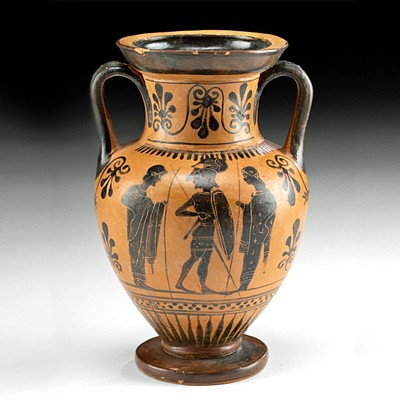Superb Persian Achaemenid 23K+ Gold Lion Appliques
Lot 109
About Seller
Artemis Gallery
686 S Taylor Ave, Ste 106
Louisville, CO 80027
United States
Selling antiquities, ancient and ethnographic art online since 1993, Artemis Gallery specializes in Classical Antiquities (Egyptian, Greek, Roman, Near Eastern), Asian, Pre-Columbian, African / Tribal / Oceanographic art. Our extensive inventory includes pottery, stone, metal, wood, glass and textil...Read more
Categories
Estimate:
$8,000 - $12,000
Absentee vs Live bid
Two ways to bid:
- Leave a max absentee bid and the platform will bid on your behalf up to your maximum bid during the live auction.
- Bid live during the auction and your bids will be submitted real-time to the auctioneer.
Bid Increments
| Price | Bid Increment |
|---|---|
| $0 | $25 |
| $300 | $50 |
| $1,000 | $100 |
| $2,000 | $250 |
| $5,000 | $500 |
| $10,000 | $1,000 |
| $20,000 | $2,500 |
| $50,000 | $5,000 |
| $100,000 | $10,000 |
| $200,000 | $20,000 |
About Auction
By Artemis Gallery
Mar 9, 2023
Set Reminder
2023-03-09 10:00:00
2023-03-09 10:00:00
America/New_York
Bidsquare
Bidsquare : Exceptional Ancient, Ethnographic, & Fine Art
https://www.bidsquare.com/auctions/artemis-gallery/exceptional-ancient-ethnographic-fine-art-12354
Artemis Gallery info@artemisgallery.com
Artemis Gallery info@artemisgallery.com
- Lot Description
**Originally Listed At $5000**
Near East, Iran, Achaemenid Empire, ca. 6th to 4th century BCE. A pair of 99% gold (equivalent to 23K+ to 24K) applique ornaments repousse formed into roaring lion heads with open work manes! The versos bear integral eyelet loops for suspension that could be sewn into the fabric of luxurious garments or headdresses fit for royalty. Brick reliefs from Susa and carvings from Persepolis depict rulers wearing robes with patterning that likely symbolized metal appliques such as these! Lions were a powerful symbol in Achaemenid art and were heavily featured in royal iconography to denote power and strength. The lion- with the mane streaming out like sun beams - these animals were also connected to solar deities and many sun related myths in many ancient Near Eastern traditions. In ancient Mesopotamian astrology, the sun is at its maximum strength while in the "house of the lion." Size: 2" Diameter (5.1 cm); 3.5" H (8.9 cm) on included custom stand; gold quality: 99% (equivalent to 23K+ to 24K); total weight: 9.6 grams
For a nearly identical example, please see the Metropolitan Museum of Art's website, accession number: 56.154.1.
The Achaemenid Persian Empire, founded by Cyrus the Great in 550 BCE (including Iran, Mesopotamia, Syria, Egypt, Asia Minor, Central Asia, Caucasus, Thrace and some parts of India) is generally regarded as one of the greatest civilizations of the ancient world. Its capital, Pasargadae, was Cyrus the Great's final resting place and has been named a UNESCO World Heritage Site. To demonstrate the Achaemenid Empire's love of gold, associates of Alexander the Great in accounts of a tomb in Pasargadae, described a golden sarcophagus, necklaces, and gold gemstone earrings. The tomb is located in Pasargadae, in the garden of a royal palace where an ensemble of artifacts known as the Pasargadae Treasure - including various articles of gold and silver, jewelry and gemstones - were found in a ceramic amphora.
The Achaemenid love of silver and gold was famous throughout the ancient world. Plato wrote of how the acquisition of gold and silver was considered a virtue while Alcibiades, another Athenian, wrote of the enormous wealth in gold and silver that the Persians had. Ancient Greek writers described the impressive wealth of the Persians. To quote Herodotus when speaking of Xerxes' troops, they "were adorned with the greatest magnificence …. They glittered all over with gold, vast quantities of which they wore about their persons." (Vii. 83).
PLEASE NOTE: Due to recent increases of shipments being seized by Australian & German customs (even for items with pre-UNESCO provenance), we will no longer ship most antiquities and ancient Chinese art to Australia & Germany. For categories of items that are acceptable to ship to Australia or Germany, please contact us directly or work with your local customs brokerage firm.
Provenance: private New York, New York, USA collection; ex-Jay I. Kislak collection, Miami, Florida, USA, acquired in the 1970s - 1990s
All items legal to buy/sell under U.S. Statute covering cultural patrimony Code 2600, CHAPTER 14, and are guaranteed to be as described or your money back.
A Certificate of Authenticity will accompany all winning bids.
We ship worldwide and handle all shipping in-house for your convenience.
#174677Minor tears in one or two places of mane on both, edges are curled, overall creases and wrinkles throughout. Heavier remains of earthen encrustations in recessed areas of right lion and hair line tear on eye.Condition
- Shipping Info
-
All shipping is handled in-house for your convenience. Your invoice from Artemis Gallery will include shipping calculation instructions. If in doubt, please inquire BEFORE bidding for estimated shipping costs for individual items.
-
- Buyer's Premium



 EUR
EUR CAD
CAD AUD
AUD GBP
GBP MXN
MXN HKD
HKD CNY
CNY MYR
MYR SEK
SEK SGD
SGD CHF
CHF THB
THB














